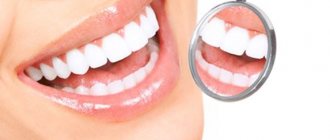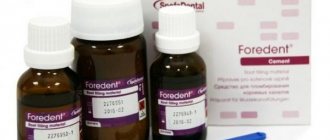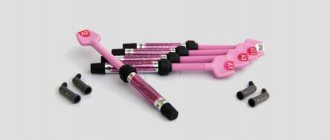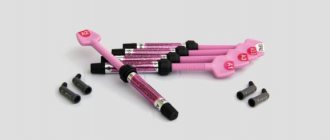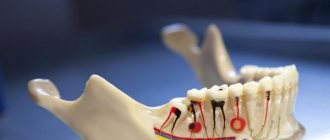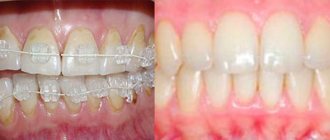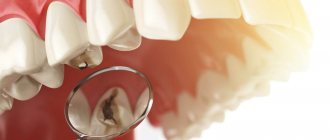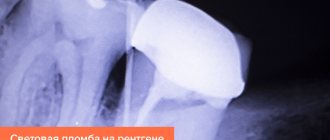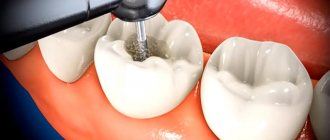And dentistry can be fun: bright colored fillings for the youngest patients
Colored fillings for children have become a real breakthrough in dentistry. Today, many modern dental clinics offer this type of filling. The popularity of such multi-colored fillings is quite understandable, because this is one of the few guaranteed ways to attract the attention of a child and relieve him of groundless fears about dental treatment. Often, this is the only opportunity to force a restless baby to sit in a chair and wait for the doctor to leave a bright spot on the tooth, which can then be shown to friends. Such cheerful multi-colored fillings for little patients will be discussed further in this article.
Indications and contraindications
The main indication for the use of the material is filling of mammary units against the background of the following clinical pathologies:
- elimination of caries cavities in the range from class 1 to class 4 , if it is possible to isolate the organ from the liquid environment of the oral cavity;
- as a mandatory preparation procedure – when treating defects located in the area of the tooth neck;
- with severe enamel erosion , the presence of wedge-shaped anomalies;
- in case of mechanical damage to the hard tissues of fragments of the child’s jaw row.
The main functional purpose of the component is to act as a reliable sealant for the entire period until the temporary organ is replaced by a permanent dental unit.
Contraindications to the use of Twinkie Star are:
- individual intolerance to the components of the drug;
- when diagnosing both direct and indirect relief of the organ pulp, as well as areas where filling is required, which will be subject to constant load.
Signs indicating the need to unfill the tooth canals and the procedure technique.
In this publication we will talk about the features of Spectrum fillings made in Germany.
Here https://www.vash-dentist.ru/lechenie/zubyi/plombyi/restavratsii-tsementnyih.html read reviews about cement fillings.
Why treat baby teeth if they are going to fall out anyway?
Many parents mistakenly believe that caries and other diseases of baby teeth do not need such close attention, because the teeth will eventually be replaced by permanent ones. In fact, a temporary tooth affected by carious processes becomes an open source for the spread of infection. If the disease is given the opportunity to progress, it will not be limited to just one tooth, but will quickly spread to neighboring ones and will definitely reach the rudiments of permanent teeth. As a result, the child may have serious dental problems in the future. All this suggests that baby teeth are not only possible, but absolutely necessary to be treated, and this should be done when the first signs of a problem appear.
If left untreated, baby teeth can lead to problems with permanent teeth.
If we are talking about the rapid development of caries, then the most common method of treating the pathology is filling. Many mothers and fathers are perplexed why children are given fillings on teeth that will sooner or later fall out. The anxiety of parents is understandable, because they simply do not want to expose their children to unnecessary stress associated with the frightening buzzing of a drill, which they themselves have been afraid of since childhood. But treatment of children’s primary teeth is a prerequisite for the health of permanent ones, and several good reasons can be given for this:
- the roots of baby teeth are in direct contact with the rudiments of permanent teeth. Thus, any even minor problem with a temporary tooth will inevitably affect the condition of the permanent tooth and can even lead to the development of pulpitis,
- if you lose a baby tooth too early, it will certainly affect the state of the bite, may create some difficulties for the eruption of permanent units and even cause a change in the shape of the face,
- also, early loss of primary teeth can provoke certain speech defects,
- the lack of timely treatment for the development of caries can open access to infectious contamination of the body,
- If there is a need for orthodontic treatment, the teeth will still have to be healed, since one of the strict conditions for the installation of any corrective apparatus is the absence of open carious cavities and other dental diseases.
If there is a need for dental treatment, and we are talking about a child, it is important to take a responsible approach to finding a clinic and choosing a pediatric specialist. Treatment methods for primary teeth have their own characteristics and nuances, and only an experienced, qualified dentist will be able to choose the best solution to the existing problem.
Choose only experienced doctors to treat children's teeth
Instructions for use
The composition is introduced into the cavity in layers. The thicker the filling, the more layers need to be applied. As they are applied, polymerization occurs. In this case, the maximum permissible coating thickness is no more than 2 mm.
Special caps, translucent matrix devices, and wedges with a high degree of light conductivity are used.
In this case, the end part of the apparatus should be extremely close to the surface of the working area, so that a good quality of adaptation of the mass to the hard tissues of the tooth can be achieved.
If the distance is more than 5 mm, then a decrease in the depth of the cavity is observed, which will negatively affect the polymerization process. And this, in turn, is fraught with insufficient marginal adherence, subsequent pigmentation and the development of pulpitis of bacterial origin.
The finished surface is processed only after removing the matrix. This is done with special discs, after which the working area is covered with a varnish that fixes the result.
Multi-colored fillings – both children are delighted and parents are calm
Gone are the days when the dental chair was associated with the terrifying sounds of a working drill, children's tears and screams. Today, dentistry is looking for and finding more effective, safe and completely painless methods of treating dental diseases, as well as ways to interest young patients and help them cope with their fears. Children's multi-colored fillings are an excellent opportunity to attract the baby's attention, arouse his interest and ensure that he sits quietly in the chair until the end of treatment, because he will also be curious to look at the result. Such fillings are created from a material such as compomer - a combination of glass ionomer cement and a hybrid composite1. Just look at the photo below - how interesting they look on children's teeth.
This is what fillings on a child’s teeth look like
“Yes, I myself am delighted with these colored fillings! Well, that's where the cuteness is! My daughter was diagnosed when she was 3 years old and it turned out to be such a cute pink spot on her tooth. It's been three years now and it's holding up great. But recently a hole appeared on another tooth, but since we had already moved to another city by that time, we had to look for a new clinic. This time we chose bright green and glitter. It also holds up great. Eh, if this had happened in my childhood, I wouldn’t have left the dentist.”
Milana_1984, Nizhny Novgorod, from correspondence on the woman.ru forum
So, let's look at the undeniable advantages of children's multi-colored fillings and why they are so popular today:
- fluoride content: this substance makes the enamel of children's teeth stronger and more durable. Thus, the filling also has a therapeutic effect,
- long service life: the strength and reliability of the installed filling is due to the tightness of its adherence to the dental tissues, and all thanks to glass ionomers and other composites included in the material. The service life of such colored fillings is on average 3 years,
- rapid hardening: the filling hardens under the influence of an ultraviolet lamp, and the filling process itself takes very little time. In addition, the composition is placed into the tooth cavity immediately from the capsule, and, accordingly, it does not require any preliminary preparation,
- relatively low cost,
- awakening the baby’s interest in oral care and daily brushing of teeth,
- the ability to promptly notice that the filling has begun to wear off due to its bright color,
- eliminating fear of dental treatment.
Currently, pediatric dentistry offers a variety of colors to choose from: pink, blue, green, yellow, orange, silver and gold, with or without sparkles. All colors are bright and rich. According to reviews, girls usually choose pink and yellow fillings, while boys prefer blue and green fillings.
The ability to choose your own color attracts the child's attention
General presentation and purpose
Twinkie Star is a unique compomer radiopaque material characterized by a high degree of light curing. It has a glitter effect and is intended for filling baby teeth in children.
The product polymerizes with a blue halogen-neon color and is used in combination with enamel dentin bond.
Produced in Germany using VOCO technology, which is based only on innovative techniques and scientific developments in the field of pediatric practical dentistry.
Convenient packaging makes it easier to install the filling, reduces treatment time, and relieves psychological discomfort and fear.
How is filling done?
Treatment with the installation of a colored filling can be divided into several stages. Let's take a closer look at this simple process. So, filling includes the following steps:
- anesthesia - for this purpose, the doctor can give an injection of an anesthetic or, for example, offer an inhalation method of administering an anesthetic,
- after this, the specialist clears the cavity from damaged tissue, for which a drill, laser or sandblasting is usually used,
- then the doctor evaluates the condition of the pulp. If the neurovascular bundle is not damaged, it is disinfected. In the same case, if the pulp is inflamed, the doctor will have to remove it,
- making sure that caries is completely eliminated and the cavity is cleared of bacteria, the dentist protects the nerve with a special gasket,
- filling - the cavity is filled layer by layer with material, which is then exposed to ultraviolet radiation and hardens. After this, the treated tooth is polished and ground.
The photo shows the process of exposure to ultraviolet light on a filling.
In order to eliminate, if possible, factors that can provoke the development of caries in a child, you should carefully monitor what he eats. Try to exclude sweets from his daily diet, since sugar becomes the main cause of tooth decay in childhood. It is equally important to teach your child to brush their teeth every day, and this needs to be done correctly. A pediatric dentist can teach you proper techniques for cleaning enamel from plaque and deposits during a routine examination. If you do not want to subject your child to dental treatment, even with such bright and cheerful fillings, carefully monitor the condition of his mouth and teeth, and also do not forget to show your child to a specialist 3-4 times a year.
- Batyukov N.M., Ivanova G.G., Kurganova I.M. Comparative assessment of the effectiveness of methods of treatment and filling of root canals using modern technologies, 2007.
Price
The cost of a set consisting of 40 capsules will be about 7,600 rubles. For the treatment of one baby tooth with this composite, taking into account the initial examination, diagnosis and filling itself, you will have to pay about 2,000 rubles.
The material itself for one unit, excluding the work of a specialist, will cost the parents of a young patient 700–900 rubles.
Reviews
Ivan, 45 years old
If I had had colored fillings when I was a child, I don't think I would have been so afraid of dental procedures. I remember running away from my mother so as not to go to the dentist. It was very scary.
Larisa, 32 years old
My son got a colored filling a year ago. It holds up great. When the doctor showed him a palette of colors and told him what his tooth could look like after treatment, the son enthusiastically began choosing a color. Stopped on green. During the treatment I never made a peep. At home he showed off his green tooth to everyone and was very proud.
Alisa, 29 years old
We had two experiences installing colored fillings. One was placed on my daughter when she was 3 years old. A small pink spot appeared on the tooth and has been holding on well for three years now. Then we moved and had to go to another dentist in another clinic for the second tooth. They put in an orange filling with glitter. It fell out after a year. Either it was the sparkles, or the doctor was like that, in general, the second experiment turned out to be unsuccessful.
What anesthesia is used?
Baby teeth, like molars, have nerves, so they can hurt. During treatment, different types of anesthesia are used (according to the depth of tissue damage). There are three types of anesthesia, including:
- applique. It is a spray or gel that reduces sensitivity only on the surface of the oral mucosa. Application anesthesia is harmless and completely safe for the child’s body. It is often resorted to before removing a moving molar. For the treatment of caries or pulpitis, topical anesthesia is not enough;
- infiltration The technique involves an injection that blocks the nerve endings of the desired area. The new generation of drugs act instantly; after 2-3 minutes the doctor begins to treat caries, pulpitis or remove a fixed molar. During manipulations, the child is not tormented by painful sensations;
- conductor. This is the most powerful type of pain relief. It affects the nerve branch of a large area. Conduction anesthesia is used in rare cases when infiltration anesthesia is not enough (for example, if it is necessary to treat several teeth at once).
In pediatric dentistry, products based on articaine hydrochloride are used as an anesthetic.
In pediatric dentistry, products based on articaine hydrochloride are used for local anesthesia. The active substance has pronounced analgesic properties, but is non-toxic.
It rarely causes an allergic reaction and remains in the body for a short time. It is allowed to be used by children over 4 years of age.
Advantages of SM-Dentistry
- Qualified pediatric dentists The best dentists in Moscow work here, having extensive experience in treating children. Knowing the basics of child psychology, doctors establish trusting relationships with the little patient and carry out all therapeutic and diagnostic manipulations in a playful manner. This avoids fear and stress in the child. Our dentists explain in an accessible manner the importance of treatment and teach the child how to properly perform hygiene procedures.
- Comprehensive services We monitor the oral health of our patients from the moment the first tooth appears. Regular preventive examinations make it possible to identify diseases in the early stages, when treatment can be carried out quickly and painlessly. We perform dental fillings under local anesthesia (application + injection), under sedation (if the child is anxious) or under anesthesia (if several teeth need to be treated at once). Thanks to qualified anesthesia, these procedures are absolutely safe for children.
- The best materials Doctors use advanced equipment and certified materials from world-famous manufacturers in their work. We use only those medications that are registered in our country and are absolutely safe for the youngest patients.
You can find out more details and sign up for a consultation with a specialist by calling: +7
, or by filling out the form:

